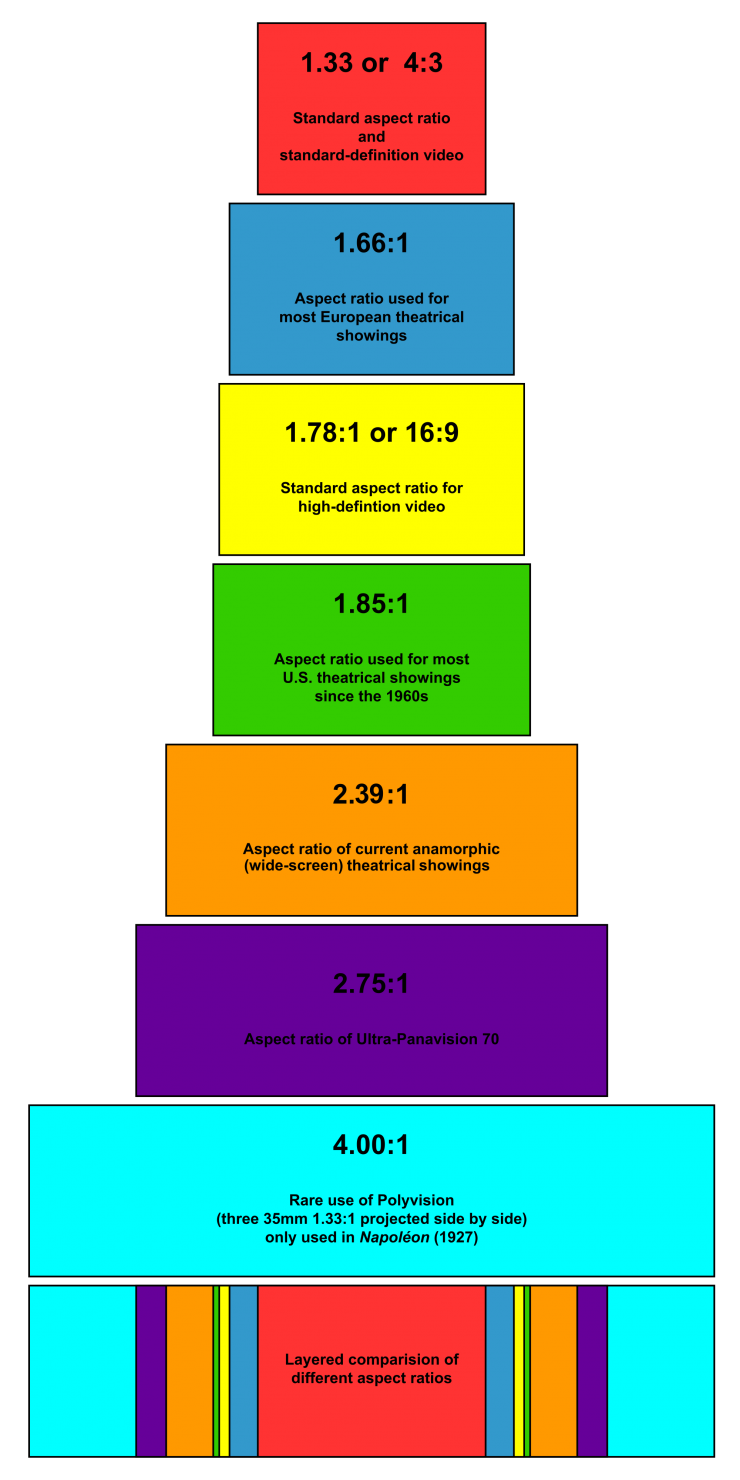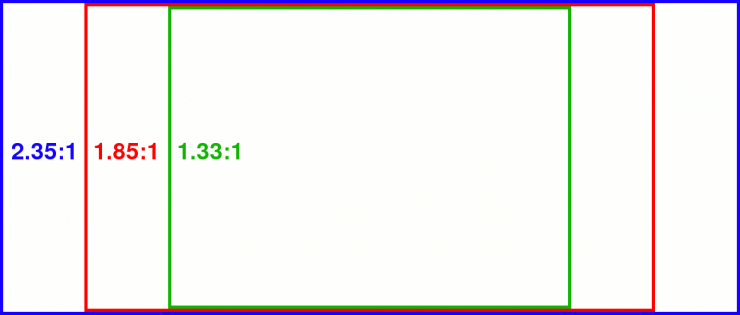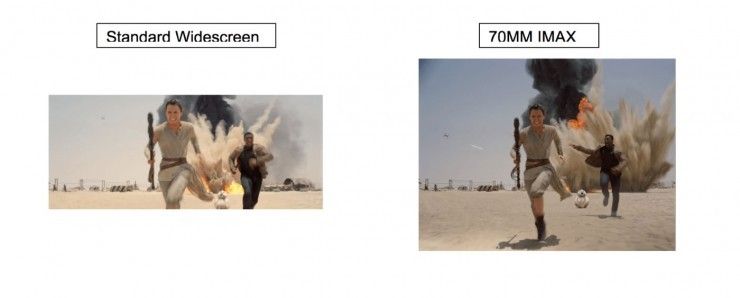
How can the aspect ratio of your film or TV show contribute to your story?
Whether you're watching a show on your iPhone, setting up your new 70in 4K television, or sitting your butt in a theater, aspect ratio matters. The aspect ratio refers to the size of the image displayed on your screen. While this sounds technical, aspect ratios can help storytellers add another layer to their repertoire. Also, for independent filmmakers and huge studio directors, the right aspect ratio can attract more viewers and create a buzz around your film or TV show.
There's a lot to learn when it comes to aspect ratios. Like which aspect ratios matter in social media and which aspect ratios make sense for Netflix and Amazon versus theatrical.
So strap in and let's talk aspect ratios in film and TV!
What Is Aspect Ratio?
The aspect ratio of an image describes the width and height. It's usually written as two numbers separated by a colon, as in 16:9. It can also be written with an “x” between the numbers. Like 3x4.

Video is no longer available: vimeo.com/255452914
Aspect Ratio History
Aspect ratios have changed over time, depending on what people use to view media. As screens got bigger, aspect ratio adjusted. As they got smaller, it continued to happen. Over 100 years ago, the very first films were projected in 4:3. The standard film strip was run through a projector and light behind it through the image onto a wall. The 4:3, or 1.33:1, was the literal measurement of the strip.
As film evolved, so did the aspect ratio. Film strips eventually became 1.37:1, and that became the standard for cinema across the globe.
1.37:1 was the ratio officially approved by the Academy of Motion Picture Arts and Sciences in 1932. They made it the standard and people started calling it the Academy Ratio.
In the 1950s, TV became ever more popular. People started going to the theater less, and theatrical distributors knew they needed to make a change. So they went even bigger, with Cinerama.

What's Cinerama's Aspect Ratio?
Cinerama was the first widescreen format to be introduced after the Academy Ratio became a standard in 1932. It involved projecting images from three synchronized 35mm projectors onto a deeply-arced screen. It utilized aspect ratios of 2.59:1 to 2.65:1 to make images seem huge.

Eventually, Cinerama got some competition with CinemaScope.
What's CinemaScope's Aspect Ratio?
CinemaScope used aspect ratios of 2.35:1 to 2.66:1. It only had to use one projector to get the image on the screen, so it was preferable to Cinerama. Developed by Earl Sponable, who was the head of research at 20th Century Fox, CinemaScope was last used in 1967, the term "scope" is still used by projectionists and filmmakers to refer to any movie that uses anamorphic lenses or with an aspect ratio of 2.35:1 or more.

It's funny to think that even in the 1960s, theaters were trying to find a way to get people to watch less television and to come to the movies. Especially since we're having similar troubles today. Nowadays, if you want to go to the theater to see something projected, you can choose from 35mm or the much larger 70mm.
What Aspect Ratio does 70mm Film Deliver?
70mm has caught back on recently, since Tarantino, Nolan, and Paul Thomas Anderson have all elected to have their films projected in the huge format. 70mm boasts an aspect ratio of 2.76:1 – twice as large as the standard 35mm film. 70mm was what put Ben-Hur on the map in 1959, and now it's a way that filmmakers are getting people out to see the spectacle. 70mm is often combined with IMAX formats.
The modern IMAX design uses 70mm film that is shown horizontally with a massive 15 perforations per frame, giving it approximately six times the resolution of 35mm film. The average IMAX screen size is approximately 72' x 50' (22m x 16m), which is significantly larger than traditional movie screens of approximately 50' x 20' (16m x 6.1m).

Modern TV and Film Aspect Ratios
TX boxes were 4:3 until widescreen televisions debuted in the 2000s. Many older programs had to convert their 4:3 shows to 16x9. But people who watched movies on TV rejoiced. The theatrical experience had finally come home. And as TVs grew in size, aspect ratios began to reflect the change.

How To Choose the Right Aspect Ratio
So now we're in the digital era. We don't have to rely on the size of the film stock to reflect our aspect ratio. And if you have the money to shoot in 70mm, you still might not want to. People are creating lots of different media content. We're shooting shorts, digital series, movies, TV shows, commercials, Instagram videos, Facebook posts, and Snapchats.
Let's go over some aspect ratios in social media to make sure the content you're producing fits within modern formats.
Video is no longer available: www.youtube.com/watch?v=4KKVsOEiHuc
Aspect Ratio for Social Media
Instagram Aspect Ratio
If you're going to do it for the 'gram, you should do it with the right aspect ratio. Instagram has specific guidelines for what works on its site.
- Square (1:1)
- Standard Horizontal (16:9)
- Alt Horizontal (1.91:1)
- Vertical (4:5)
Facebook Aspect Ratio
We all love to shoot stuff to post on Facebook. Whether its the trailer for your new venture or a web series, you want people to be able to like and share the best content. Facebook supports:
- 16x9
- 9x16
- 4x5
- 2x3
- 1x1
You can upload phone videos, movie trailers, and fluidly share videos from all other social channels if they occur in the aforementioned formats.
Twitter Aspect Ratio
Like Facebook, Twitter is a great place to get your message out there. It's great to get retweets and social engagements. Twitter is one of the best places to get your message put to the people and to interact individually. Twitter supports the following aspect ratios:
- 1x1 1200 X 1200
- 2x1 1200 X 600
- 3x2 1200 X 800
Aspect Ratios for Streaming Services
So her'es the deal: lately, some streaming services have been cutting off almost 25% of movies by reformatting them to fit 16x9 televisions. While this practice is supposed to stop, with letterboxes being added to share the proper format, you should still be aware. If you're creating content for Netflix, Amazon, or HBO, you should know their aspect ratios. That way you'll know how your work is presented on the screen.
Netflix Aspect Ratio
Netflix shows almost everything in 16x9. So if you're trying to watch a movie that's natively in 2.39:1, you're going to get the black bars. They also have been known to use 2:1 aspect ration. This aspect ratio is also used in many new Netflix series and is less wide than scope, but still gives the viewer the sense of a wide screen.
Amazon Aspect Ratio
Amazon's aspect ratio is 16x9.
HBO Aspect Ratios
HBO's aspect ratio is 16x9. But some of their older shows, like Curb Your Enthusiasm, can still be shown in 4:3.
How Aspect Ratio Can Help Your Story
Okay, we've gone through lots of different kinds of aspect ratios, but now it's time to talk about how aspect ratio can help your story.
Think about how Christopher Nolan used IMAX and 70mm to give Dunkirk the largest aspect ratio possible.
Making Dunkirk huge wasn't just to drive people to the theater. It was to envelop audiences in the heat of battle, to make them feel the pressure of these men, and to give the entire story scope.
Or what about Paul Schrader's choice to use Academy Ratio, 1.37:1 for First Reformed?
Squeezing that movie into a more boxy proportion makes you feel the claustrophobia of the world we're in. We're under pressure and going through our passion with Reverend Toller. It also gives the movie a more classical feel. It's a throwback, like the church, and an homage to Hollywood of yesteryear.
Your aspect ratio is not just a mathematical tool. It's also a way to enter your story and add another layer. So think about it before you start shooting.
What's an Aspect Ratio Calculator?
Let's say you have a video you shot, or a movie trailer, or even a digital series you want to debut across different channels. An aspect ratio calculator will help you do the math to see how it can fit in other formats. Aspect ratio calculators came in handy for anyone who had to post-convert a TV show made before the 2000s and put them in widescreen.
Or what if you shot in IMAX, but are showing your project on a standard screen? Like some did for The Force Awakens.


Try this aspect ratio calculator by Digital Rebellion.
Try this aspect ratio calculator by Red Route.
Try this aspect ratio calculator by Ratio Calculator.
Summing Up Aspect Ratio
Aspect ratios in film and television have changed over the years, but the one thing that stays consistent is people's desire to create and show their work in the proper format. So if you're making movies, shorts, commercials, TV shows, or just shooting with friends, make sure you know the aspect ratio where you're going to upload or project.
We even have some free aspect ratio templates for you to use.
On the technical side, make sure you know your lenses. They can help you decide what to shoot and how to shoot it.
If you want to learn the storytelling first, check out our Screenwriting page. The first step in getting your aspect ratio to work for you is to get the story down on the page.
I can't wait to see how you utilize your aspect ratio knowledge!
Your Comment
4 Comments
I'll add 2:1
February 25, 2019 at 12:37PM, Edited February 25, 12:37PM
Nice write up, very thorough.
February 25, 2019 at 5:16PM, Edited February 25, 5:16PM
netflix is the best
May 28, 2019 at 5:28AM, Edited May 28, 5:28AM
thank you
November 8, 2019 at 6:29PM, Edited November 8, 6:29PM